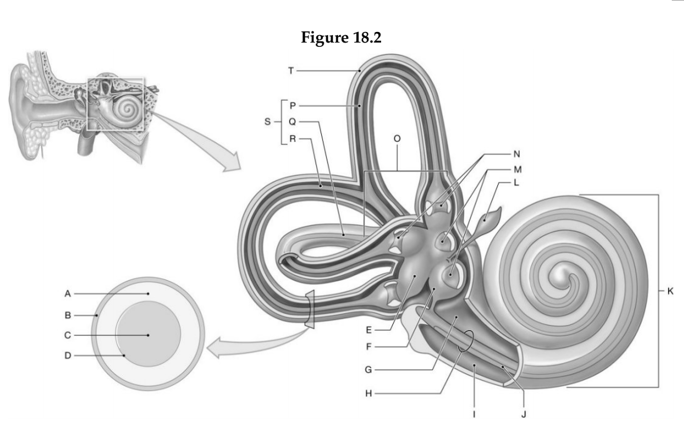Using the figure below, identify the labeled part.

1. Label A: ______________________________
2. Label B: ______________________________
3. Label C: ______________________________
4. Label D: ______________________________
5. Label E: ______________________________
6. Label F: ______________________________
7. Label G: ______________________________
8. Label H: ______________________________
9. Label I: ______________________________
10. Label J: ______________________________
11. Label K: ______________________________
12. Label L: ______________________________
13. Label M: ______________________________
14. Label N: ______________________________
15. Label O: ______________________________
16. Label P: ______________________________
17. Label Q: ______________________________
18. Label R: ______________________________
19. Label S: ______________________________
20. Label T: ______________________________
1. Perilymph
2. Bony labyrinth
3. Endolymph
4. Membranous labyrinth
5. Utricle
6. Saccule
7. Vestibular duct
8. Cochlear duct
9. Tympanic duct
10. Organ of Corti
11. Cochlea
12. Endolymphatic sac
13. Maculae
14. Crista within ampullae
15. Vestibule
16. Anterior semicircular duct
17. Lateral semicircular duct
18. Posterior semicircular duct
19. Semicircular ducts
20. Semicircular canal
You might also like to view...
Describe the opposing ways that the muscular system and integumentary system act as effectors in the regulation of body temperature
What will be an ideal response?
Most of testosterone's actions ultimately function to ensure delivery of sperm to the female
a. True b. False Indicate whether the statement is true or false
All of the following disorders fall under chronic pulmonary obstructive disorders except which one?
A. Pneumonia B. Asthma C. Emphysema D. Chronic bronchitis
Which of the following is NOT a primary odor class?
A. umami B. floral C. putrid D. pepperminty E. ethereal